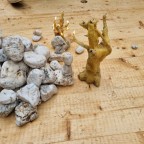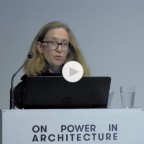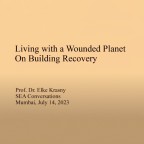Encounters V. October 29-31, Zagreb
Acting Out. Remembering the Past and Responsibility for the Present
October 29 – 31, 2010 Zagreb
(in Croatian and English language)
Encounters V event is part of the project
Mnemosyne – Theatre of Memories/Part I: Getting Together.
There is no doubt that an enormous tremor [occurred] in this city with the begining of fascism, that meant an unbelievable braindrain. On one side there was the expulsion and extermination of the Jewish intelligence, on the other side the political female resistance was also threatened by the Nazi terror. After WWII, this resulted in an image of what women ought to be which was a lot more conservative than the image of women ten or even twenty years before WWII. Basically we have not recovered yet. The period of WWII is an extremely aggravating wound in the history of this city.
Elke Krasny in interview with Sabine Meier, translated from German by Sonja Leboš
Programme
Friday, October 29, 2010
Discussion
Remembering the Past and Responsibility for the Present (in Croatian language)
Public Library ‘Bogdan Ogrizović’, 16 – 18.00
Presentation of the book Mnemosyne – Theatre of Memories / Part I: Getting
The book has come out as the result of this year’s endeavour of Association for Interdisciplinary and Intercultural Research (AIIR) to activate remembrance of totalitarian regimes of the XXth Ct and discuss its reflections in contemporaneity, and at this ocassion it will serve as an introduction to the discussion under the title Remembering the Past and the Responsibility for the Present.
The discussion is to be enriched with the contribution by two young lawyers who are talking about their research under the title ‘The Fate of Jews in Međimurje (Northern Croatia)’, and by Jadranka Kim Musa who investigated in fate of contemporary Roma in Croatia and Hungary.
The closing word is being precedeed by Milan Ogrizović, the son of one of the victims of the terrible ustashas’ reprisal over antifascists that took place on today’s Park of December 1943 Victims in Dubrava, Zagreb. Milan Ogrizović is reading from his mother’s book Reprisal.
Presentation of the book ‘City and Women. Another Topography of Vienna’ by Elke Krasny
Centre for Women’s Studies, Memorial Apartment Maria Jurić Zagorka, Dolac 8
Friday, October 29, 2010. 19.00 – 21.00 (in English)
The book City and Women. Another Topography of Vienna was made after Elke Krasny had shared daily walking routes with 20 women in the city of Vienna. What came for is a set of stories about present and past of Viennese women, such as Alma Rosé, a violine player killed in Auschwitz, Dorothea Neff, actress, righteous among the nations who used to hide her Jewish colleague during the WWII, Veza Canetti who described the Vienna Yellow street in the book of the same name, and many, many more.
What is the connection between present and past in the tissue of a city, who are the agents of inscribing history in space and where are the links with future?
By this occasion, Elke Krasny is trying to answer these question.
Saturday, October 30, 2010
Workshop ‘Zagreb – City of Remembrance’
Centre for Women’s Studies, Memorial Apartment Maria Jurić Zagorka, Dolac 8
Saturday, October 30, 2010. 10.30-13.00 (in English)
As urban researcher and curator, Elke Krasny works with problems of space production, mnemopolitics, representations and identity constructs. Spaces of remembrance or mnemotopias are places where she intervenes and enables alternative layers of history to emerge. The method of narrative urbanism that she conceptualized and applied in many projects links personal memories with locations of collective remembrance. The exhibition “City and Women. Another Topography of Vienna” that took place in Vienna Library in Vienna City Hall in 2008 and 2009, showed a feminist remapping of Wienna city history through actual and personal daily routes of twenty women living in Vienna. The book of the same name is serving in this workshop to explain the curatorial research methodology.
Participants of the workshop can use this opportunity to go deeper into the methodologies of transforming daily walking routes to constructive grid of remembrance production: these daily routes are becoming the point of departure for articulation of Zagreb’s collective remembrance traces and personal memories of the time before 1991, of the time which now in official documents is described as ‘communist regime’.
Citizens of Zagreb are invited to share their personal routes through the city. The goal is to penetrate hegemonial culture of remembrance from gender histories perspective and to raise awareness of connections between physical space and mnemopolitics.
It is about linking the everydayness to the cityspace and its remembrance layers from the time of the WWII and socialism epoch. The participants of the workshop are invited also to look for witnesses of those time in their own milieu, to emphasise the importance of intergenerational communication.
Individual walks
Walking through Zagreb to remember (in English) with Elke Krasny/Sonja Leboš are to be scheduled in accordance to participants’ needs: on Saturday (October 30) 14.30-16.00, and Sunday (October 31) afternoon, 15.30-19.00.
Presentation of the publication Mnemosyne – Theatre of Memories
Literary Club BOOKSA, Martićeva 14d
Saturday, October 30, 2010 17.00 – 19.30
The book Mnemosyne – Theatre of Memories serve partly as a sort of both textual and visual libretto for continuance of work on the theatre installation in 2011, and partly as a sort of theoretical reader about cultures of remembrance, in cinema, education, public space and theatre.
Public Performative Action inVISIBLE
7 Prague St. (at the location where Zagreb Synagogue used to be, before being destroyed by ustasha regime in 1941)
Saturday, October 30, 2010.
21.15 – 21.45
Sometimes invisible presences are stronger than visible ones. The story of Zagreb Synagogue is like an urban myth: there is a belief that where a synagogue has been once, nothing else can be constructed. Is that a reason that on the place of the destroyed synagogue Zagreb has a parking lot?!
Invisible presences are sometimes stronger than visible ones.
Concept: Sonja Leboš; Costumes and objects: Patrizia Donna; Performers: Patrizia Donna, Stella Leboš
Sunday, October 31, 2010
Visiting Park of December 1943 Victims and Memorial Site Dotrščina
Meeting Point: final tram station of tram lines 7, 11 and 12 at 10.30
Sunday, October 31, 2010. 10.30 – 14.00
Visiting the monument for WWII heroes at Mirogoj Cemetery
Meeting Point: in front of the Mirogoj arcades at 17.00
Sunday, October 31, 2010. 17 – 19.00
Park of December 1943 Victims and Memorial Site Dotrščina are among the most important sites for commemorating victims of fascism in Zagreb. Both sites are marked with monuments designed by significant authors. This opportunity will be used to collectively contemplate forms of commemorations for many unmarked sites in Zagreb, while walking.
Elke Krasny’s workshop and visiting Park of December 1943 Vicitims and Memorial Site Dotrščina are also part of AIIR project aRs PUBLICae.
Further inquiries at: office@uiii.org
Phone: 61 80 547, Mobile: 091 506 26 82
Support: EU Commission – EACEA, ‘Europe for Citizens’ Programme, Action 4. Active European Remembrance.
City of Zagreb – Office for Education, Culture and Sport, Ministry of Culture – Republic of Croatia
Elke Krasny presentation and workshop, as well visit to Park of December 1943. Victims and Memorial Park Dotrscina are also part of AIIR’sproject aRs PUBLICae.
www.1postozaumjetnost.wordpress.com
In cooperation with:
Center for Women’s Studies, Zagreb
Croatian Artists’ Society and Gallery Karas
Literary Club Booksa
Public Library ‘Bogdan Ogrizović’



